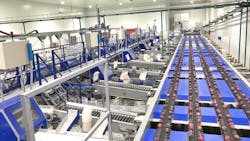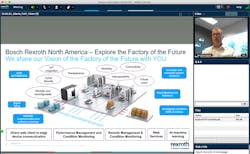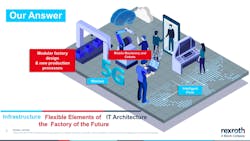Industrial automation solutions giant Bosch Rexroth hosted its virtual Explore the Factory of the Future event on July 13–16. While the industry catches up to the pitfalls of the COVID-19 pandemic, the event looked forward to the future—a future in which factories operate almost autonomously.
Matthias Aberle, vice president of Bosch Rexroth, North America opened the event with a keynote discussing why automation is crucial for the industry and how the company can help factories with their automation goals. “Only the floor, walls and ceiling are fixed,” he said. “Everything else is variable.”
Aberle discussed how digitalization can help factories become less vulnerable to pandemics like COVID-19. Connected assisted systems complement human labor while software can allow for adherence to social distancing. Incorporating tools that allow automation provides more flexibility to deal with future disruptions.
Aberle said that the manufacturing industry is playing catch-up when it comes to digitalizing its operations, and “Industry 4.0 is a prerequisite for competitiveness.”
Thomas Fechner, head of Central R&D at Bosch Rexroth, took a step inside and explained what the factory of the future might look like.
Fechner said that there has been an influx of what is called COVInnovations—advances made in response to the COVID-19 pandemic. “These come along with new products that were generated in a higher speed,” he said. “For example, camera systems to detect people who are potentially infected with COVID, or robotic systems which support us in preventing infection.”
He said that 3D printing is becoming more popular, especially as it becomes more industrialized. Another trend of innovation is the IT/OT convergence, which, according to Fechner, will create a new field of cybersecurity, which he declared “the most underrated topic.”
With innovation also comes the green tech movement, a trend that has been emerging for decades. Fechner said companies need to challenge today’s system approach, starting with the production building. The general purpose of simply housing a production line needs to be changed. A factory of the future will be an infrastructure that “provides the flexible elements of the factory,” which includes smart flooring and a more secure environment.
Fechner also explained that instead of specialty machinery, more flexible elements can pave the way for more autonomous processes. Another place for improvement is the information flow. As processes gather more data, there needs to be a better way to collect and store that data.
“You need to have access to the data system, to the IT architectural plant everywhere in every niche of your building,” he said.
Robotics will also play a large role in the future autonomous factories—not to replace humans, but to aid them. Fechner described two Bosch Rexroth robotic systems that have the ability to move boxes from one place to another, in addition to a cobot system that detects humans before contact is made.
Other robotic innovations will include model-free gripping, which means the robot does not require geometric information for pick-and-place applications.
About the Author

Marie Darty
Group Multimedia Director, Engineering & Manufacturing
Marie Darty is a digital media professional currently serving as the group multimedia director for the Manufacturing & Engineering Group at Endeavor Business Media. A graduate of Jacksonville State University, she earned her Bachelor of Arts in digital communication with a concentration in digital journalism in December 2016. In her current role, she leads the strategy and production of multimedia content, overseeing video series planning and editing. Additionally, she oversees podcast production and marketing of multimedia content.


